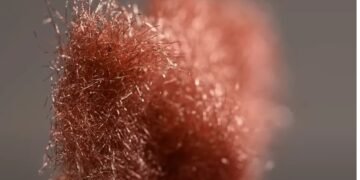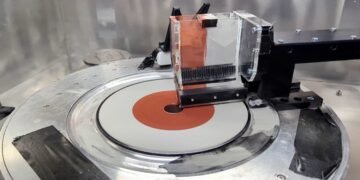Metal fleece: material for the batteries of the future
Battery electrodes thicken as a result of the accelerated transport of lithium ions via metal fleeces, making them particularly efficient and cost-effective
Batteries are becoming more and more powerful. A discovery by researchers at the Max Planck Institute for Medical Research in Heidelberg could now give them a significant energy boost. A team led by Max Planck Director Joachim Spatz has discovered that metal fleeces used as contact material in battery electrodes significantly accelerate the charge transport of metal ions, in particular. This makes it possible to build significantly thicker electrodes than is standard today. This means that roughly half of the contact metal and other materials that do not contribute to energy storage can be saved. This made it possible for researchers to significantly increase the energy density in batteries.
The status quo: A compromise between energy density and performance

“The basis for this is a previously unknown mechanism that we discovered in ion transport in electrodes,” says Joachim Spatz. Battery electrodes consist of a contact material and an active material. The contact material – today this is a copper foil for the negative terminal of lithium-ion batteries and an aluminium foil for the positive terminal – only serves to transport the current to and from the electrode. The active material is the actual storage material that absorbs and releases the charge during charging and discharging. Today, battery manufacturers use graphite in the negative terminal and various inorganic compounds containing lithium in the positive terminal. The active material is porous so that it is penetrated by the liquid electrolyte.
Although the active materials commonly used today absorb quite a lot of charge, they conduct ions very poorly. The ions must migrate through the liquid electrolyte into the active material. Because they are packed in a shell of electrolyte molecules and are correspondingly voluminous, they move sluggishly through the electrolyte. And they do not advance well in the active material itself. This presents battery manufacturers with a dilemma: Either they make the electrodes thick so that their energy density is as high as possible, but then the batteries in question cannot be charged and discharged quickly. Or they make the electrodes extremely thin and accept that the energy density will decrease in order to achieve rapid charging and discharging. With a compromise between the two properties, battery manufacturers today end up with electrodes that are around a tenth of a millimetre thin. This corresponds roughly to the diameter of a human hair.
A new approach: Accelerated ion transport through an electrical double layer
In a study published in the journal ACS Nano, the Heidelberg team has now shown how electrodes can be produced at least ten times thicker than is usual today and still be charged and discharged quickly. The researchers have demonstrated that lithium ions strip off their molecular shell on a copper surface, deposit themselves there and form an electrical double layer with electrons that accumulate under the metal surface, known as the Helmholtz layer. “Using a specially developed measurement setup and theoretical calculations, we have shown that the lithium ions move through the Helmholtz layer around 56 times faster than through the electrolyte,” says Joachim Spatz. “Metal surfaces are therefore a kind of motorway for the metal ions.”
When metal ions migrate so quickly across metal surfaces, it means that it is advisable to intersperse the active material with a metallic motorway network for ion transport. This is exactly what Joachim Spatz and his team have done. The researchers have produced fleeces from metal threads that are only a few hundredths of a millimetre thick. They then inserted the active material into the metal fleece. This meant that they only needed half as much copper as is required for conventional foil electrodes. Even if an electrode is around ten times thicker than is usual today, the lithium ions still flow into and out of the active material via a fleece so quickly that it is sufficient for use in electric cars, for example. For the fleece electrodes, the bottom line is that the energy density is up to 85 per cent higher than for foil electrodes.
Batene GmbH: A start-up for fleece electrodes
“Supplying a material with charge via two-dimensional layers is in no way efficient,” says Joachim Spatz, pointing to the example of nature: It supplies organisms via a three-dimensional network of vessels. “That is the goal of our technology: A 3D supply network for charge carriers that can be used to charge and discharge batteries efficiently.”
However, the fleece electrodes are not only significantly more powerful than foil electrodes, they are also easier and cheaper to manufacture. This is because in the production of today’s batteries, manufacturers have to apply the thin layers of active material to the contact foils in a complex process, sometimes using toxic solvents. In contrast, the active material can be introduced into the fleeces in powder form. “With dry filling, we can probably save 30 to 40 per cent of production costs, and the production facilities need a third less space,” says Joachim Spatz.
Because the researcher sees great potential in the fleece electrodes, he has already founded a start-up that is developing the battery technology for market readiness together with, for example, major car manufacturers. And this, Joachim Spatz is convinced, could also improve German manufacturers’ chances of competing in the rapidly developing battery technology: “With our technology, we have the chance to catch up with Asian manufacturers and be even better.”
Source: Max Planck Institute for Medical Research





































